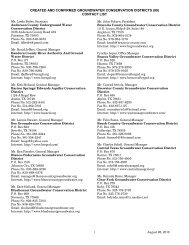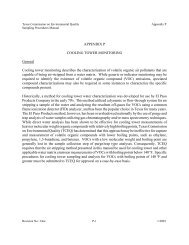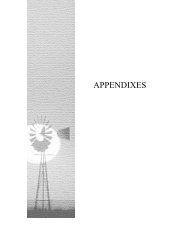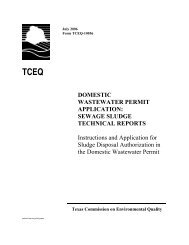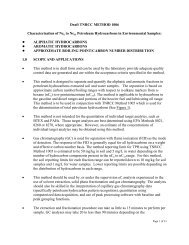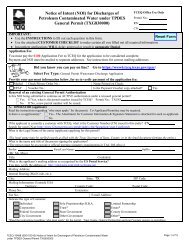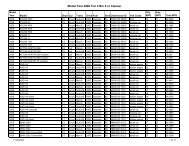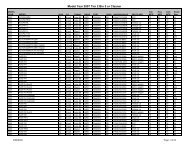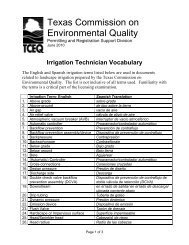Vinyl Chloride - Texas Commission on Environmental Quality
Vinyl Chloride - Texas Commission on Environmental Quality
Vinyl Chloride - Texas Commission on Environmental Quality
Create successful ePaper yourself
Turn your PDF publications into a flip-book with our unique Google optimized e-Paper software.
<str<strong>on</strong>g>Vinyl</str<strong>on</strong>g> chloride<br />
Page 10<br />
3.4 Comparis<strong>on</strong> of Results<br />
The Agency for Toxic Substances and Disease Registry (ATSDR 2006) has developed an acute inhalati<strong>on</strong><br />
minimal risk level (MRL) for VC of 500 ppb for a c<strong>on</strong>tinuous 9-day exposure based <strong>on</strong> a NOAEL of 50<br />
ppm for developmental effects in mice (John et al. 1977 and 1981). The TD did not use these studies in<br />
the development of the acute ReV for reas<strong>on</strong>s stated in Secti<strong>on</strong> 3.1.1.2. California Envir<strong>on</strong>mental<br />
Protecti<strong>on</strong> Agency (CalEPA) published an acute Reference Exposure Level (REL) for VC of 72 ppm in<br />
1999 based <strong>on</strong> a NOAEL of 261 ppm for reports of mild headaches and dryness of eyes and nose in<br />
human volunteers (Baretta et al. 1969). An Acute Exposure Guideline Level (AEGL)-1 of 250 ppm was<br />
developed based <strong>on</strong> the Baretta et al. (1969) study with a total UF of 3 (AEGL 2004). The TD ReV of 26<br />
ppm is comparable to the values based <strong>on</strong> human data.<br />
Chapter 4 Chr<strong>on</strong>ic Evaluati<strong>on</strong><br />
4.1 N<strong>on</strong>carcinogenic Potential<br />
4.1.1 Physical/Chemical Properties and Key Studies<br />
The physical/chemical properties of VC are summarized in Chapter 3.<br />
4.1.1.1 Human Studies<br />
A large number of occupati<strong>on</strong>al exposure studies are available in the literature and have identified a wide<br />
range of target organs that may be affected by chr<strong>on</strong>ic inhalati<strong>on</strong> exposure to VC (see USEPA 2000 and<br />
ATSDR 2006 for reviews). The target organs include the liver, lungs, blood, immune system,<br />
cardiovascular system, skin, b<strong>on</strong>es, nervous system, and reproductive organs, although the liver appears<br />
to be the most sensitive organ to VC toxicity. Characteristic hepatic lesi<strong>on</strong>s are produced by VC exposure<br />
and include the following characteristics: hypertrophy and hyperplasia of hepatocytes, activati<strong>on</strong> and<br />
hyperplasia of sinusoidal lining cells, fibrosis of the portal tracts and the septa and intralobular<br />
perisinusoidal regi<strong>on</strong>s, sinusoidal dilati<strong>on</strong>, and focal areas of hepatocellular degenerati<strong>on</strong> (Gedigke et al.<br />
1975, Berk et al. 1975, Falk et al. 1974, Ho et al. 1991, J<strong>on</strong>es and Smith 1982, Lilis et al. 1975, Liss et al.<br />
1985, Marstellar et al. 1975, Popper and Thomas 1975, Suciu et al. 1975, Tamburro et al. 1984, Vihko et<br />
al. 1984). According to the TCEQ ESL guidelines (TCEQ 2006), human data are the preferred source <strong>on</strong><br />
which to base toxicity factors; however, relevant human occupati<strong>on</strong>al studies do not provide accurate<br />
informati<strong>on</strong> <strong>on</strong> VC exposure levels and use of the data is limited. Therefore, data from an animal study<br />
were used to derive the chr<strong>on</strong>ic ESL for n<strong>on</strong>carcinogenic potential.<br />
4.1.1.2 Animal Studies<br />
Refer to Table 4 for animal studies c<strong>on</strong>sidered in the development of the chr<strong>on</strong>ic ESL for n<strong>on</strong>carcinogenic<br />
potential.<br />
4.1.1.2.1 Key Study<br />
Thornt<strong>on</strong> et al. (2002) c<strong>on</strong>ducted a two-generati<strong>on</strong> reproductive study in Sprague-Dawley rats. F0<br />
(parental generati<strong>on</strong>) male and female rats were exposed via inhalati<strong>on</strong> to VC c<strong>on</strong>centrati<strong>on</strong>s of 0, 10,<br />
100, or 1100 ppm for 6 h/day for a 10-week premating period and a 3-week mating period. The F0<br />
generati<strong>on</strong> male rats were exposed to VC until terminal euthanasia. F0 female rats were exposed from GD<br />
0 through GD 20 and lactati<strong>on</strong> day (LD) 4 through LD 25 (for a total of approximately 19 weeks with a



